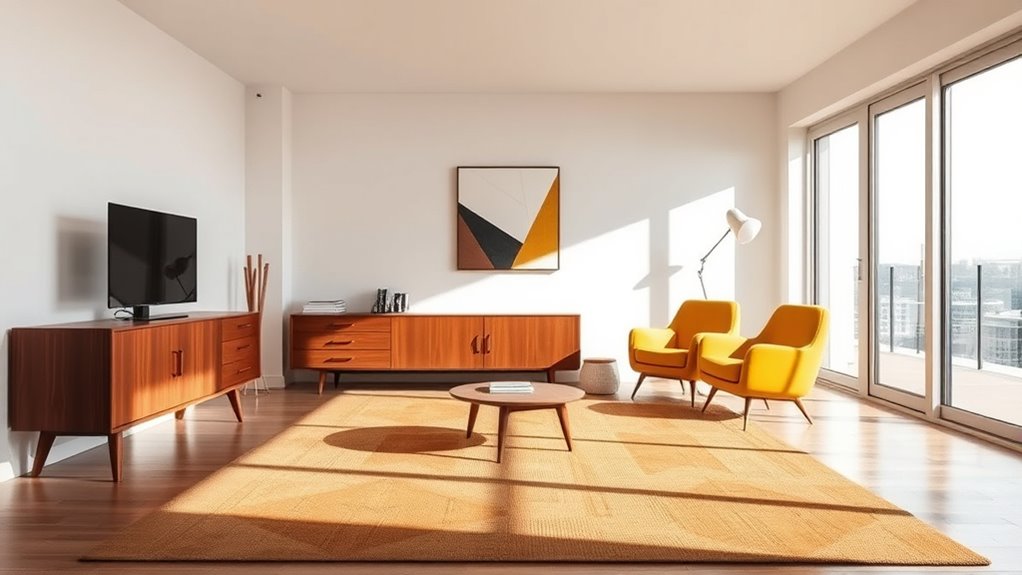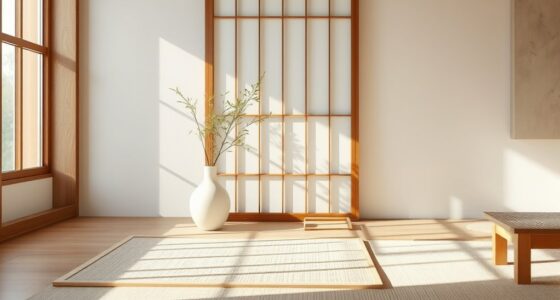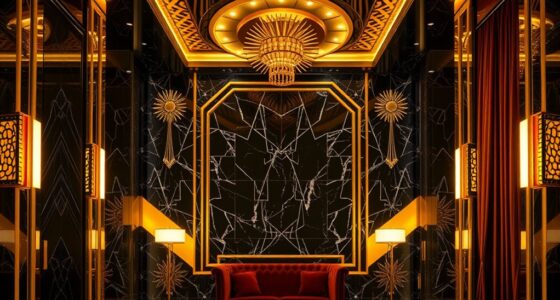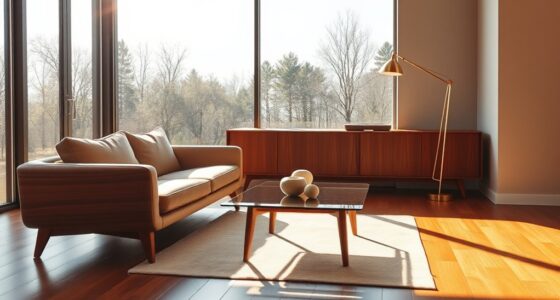Mid-century modern went from nostalgic retro to must-have thanks to clever marketing, iconic furniture, and its timeless appeal. Influential brands and media showcased its sleek designs in celebrity homes and movies, making it fashionable again. Access to vintage shops and affordable reproductions widened its reach, while its simple, functional style continues to fit modern aesthetics. Keep exploring to discover how this beloved trend became a staple in contemporary spaces.
Key Takeaways
- The 1990s reissues by brands like Knoll and Herman Miller revived MCM’s popularity and positioned it as stylish and modern.
- Media exposure through films, celebrity homes, and social platforms showcased iconic pieces, enhancing desirability.
- The availability of vintage furniture and affordable reproductions made MCM accessible to a broad audience.
- Its timeless design principles and natural materials aligned with contemporary eco-conscious and versatile interior trends.
- Strategic branding and media representation transformed MCM from nostalgic retro to a lasting, must-have modern aesthetic.
The Evolution of Mid-Century Modern Design in Popular Culture
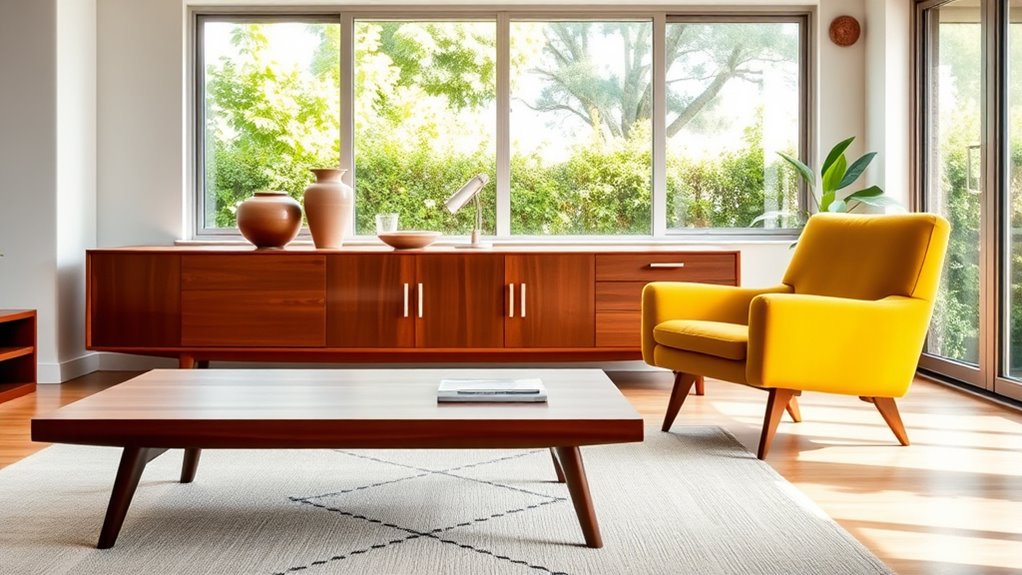
Mid-century modern design gained renewed popularity in the 1990s, thanks to the reissue of iconic pieces by companies like Knoll and Herman Miller. This resurgence brought mid-century modern into popular culture, transforming it from niche retro to a mainstream appeal. Iconic pieces like Saarinen’s Tulip Chair became symbols of stylish living, influencing movies, television, and advertising. As vintage items flooded the market, the style’s influence extended beyond nostalgia, shaping contemporary design with its emphasis on minimalism and natural materials. Its timelessness appeals across generations and cultural contexts, solidifying mid-century modern as a design movement with lasting relevance. Today, its influence persists in interior design media, celebrity homes, and modern reproductions, proving its enduring impact on popular culture. Additionally, the integration of mid-century modern elements into various design styles has helped maintain its relevance and adaptability over the years. The style’s focus on simplicity and functionality continues to inspire new generations of designers and homeowners alike.
Key Factors Driving the Resurgence of Mid-Century Modern
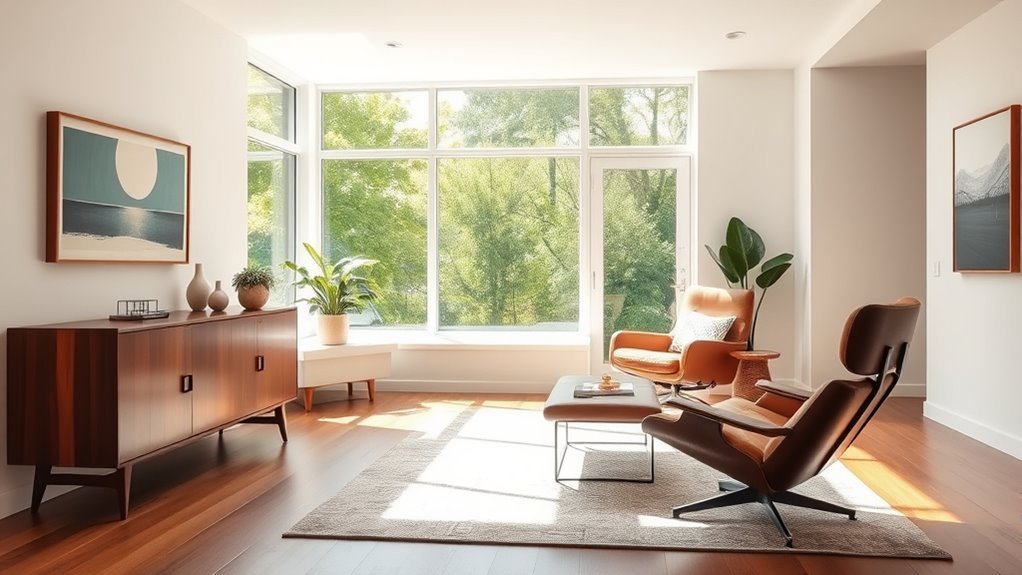
The resurgence of Mid-Century Modern design can be largely attributed to the rise of vintage furniture stores and online marketplaces like Amanda’s Exchange, which have made authentic pieces more accessible. This accessibility fuels your ability to incorporate authentic mid-century modern furniture into your interior design, highlighting natural materials and versatile design. Strategic marketing by brands like West Elm and Design Within Reach positions MCM as a stylish, high-quality choice, appealing to modern values of sustainability and eco-friendliness. Media exposure through movies and social media reinforces its cultural nostalgia and timeless appeal, attracting new enthusiasts. The style’s seamless integration into diverse spaces ensures its relevance. Additionally, understanding the design principles behind Mid-Century Modern helps homeowners and designers make informed choices that align with current trends. Recognizing the influence of global economic factors on consumer preferences can also explain its widespread popularity. The emphasis on cultural intelligence in marketing strategies enables brands to resonate more effectively with diverse audiences, further boosting its appeal. Furthermore, the bike industry’s emphasis on functional, durable components echoes the practicality valued in Mid-Century Modern aesthetics. Moreover, the use of sustainable materials in furniture production supports the eco-conscious movement that complements the style’s ethos.
The Role of Marketing and Media in Shaping Its Image

Marketing campaigns and media exposure have played a powerful role in shaping Mid-Century Modern design’s image and expanding its reach. Through strategic branding and targeted campaigns, designers and companies highlighted its timeless appeal and modernist roots, fueling nostalgia and desirability. Media representation in magazines, TV shows, and online platforms showcased iconic furniture and architecture, reinforcing its visual appeal and stylish reputation. The mainstream embrace was further boosted by celebrity homes featuring Mid-Century Modern pieces, making the style seem accessible and aspirational. Digital platforms and social media amplified this visibility, allowing a new generation to discover, share, and celebrate the aesthetic. Additionally, the influence of color accuracy in visual presentations helped to emphasize the vibrant and authentic look of Mid-Century Modern pieces across various media formats. Together, marketing and media transformed Mid-Century Modern from niche retro to a must-have design movement.
How Vintage and Reproductions Made MCM Accessible

Have you ever wondered how vintage and reproduction pieces transformed Mid-Century Modern from exclusive collectibles into accessible design staples? The rise of vintage furniture through auctions, stores, and online platforms like eBay and Craigslist made authentic MCM pieces more reachable. Meanwhile, reproduction brands such as West Elm, IKEA, and Article offered affordable options that mimic original designs, broadening access to the aesthetic. High-quality vintage pieces often come at premium prices due to craftsmanship and rarity, but reproductions democratized the style, making it affordable for many. Dedicated stores and designers focusing on reproductions expanded choices for interior design enthusiasts. This blend of vintage availability and reproduction options fueled the movement’s growth, turning Mid-Century Modern into a staple in contemporary homes worldwide.
| Vintage Furniture | Reproductions |
|---|---|
| Authentic, rare | Affordable, stylish |
| Limited availability | Widely accessible |
| High craftsmanship | Modern manufacturing |
| Premium prices | Budget-friendly |
The Enduring Appeal of Mid-Century Modern in Contemporary Spaces
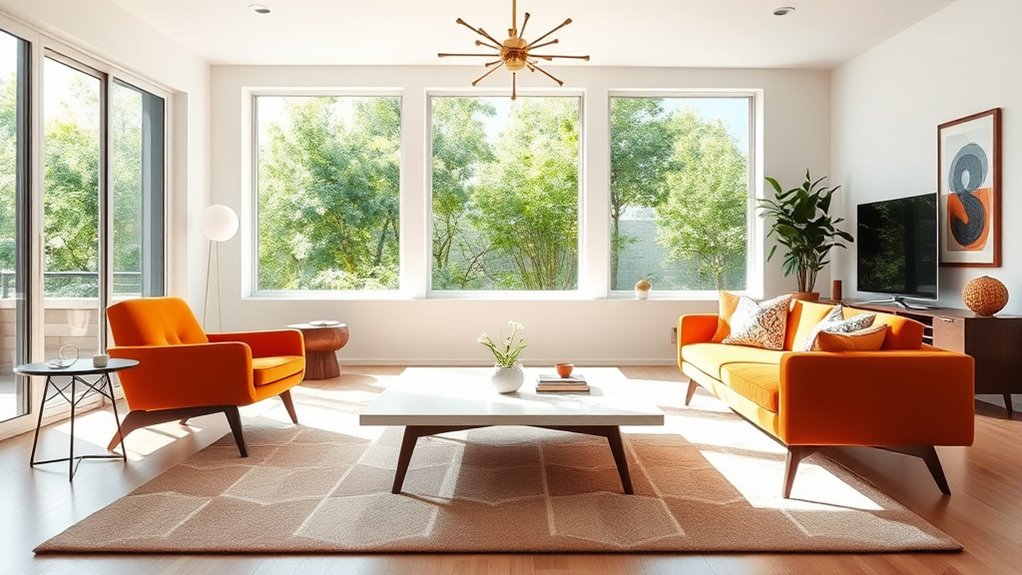
Mid-century modern design continues to captivate homeowners and designers alike because of its timeless simplicity and functional elegance. Its iconic furniture and architectural elements are frequently featured in contemporary spaces, reinforcing its status as a must-have style. The movement’s use of natural materials and organic forms aligns with eco-conscious trends, making it appealing to sustainable design enthusiasts. Its versatility allows you to blend mid-century modern pieces seamlessly with various styles, from industrial to bohemian, creating a cohesive look. The enduring popularity of vintage pieces, along with authentic reproductions, keeps this style relevant and accessible today. Incorporating interior design basics, such as mood boards and narratives, can help in understanding how to effectively integrate these elements into your space. Additionally, understanding design trends helps keep the style fresh and aligned with current tastes. Recognizing the importance of furniture restoration can also contribute to maintaining the authentic charm of vintage pieces, ensuring they remain a central feature of your decor. Regularly inspecting and caring for vintage furniture helps preserve its discoloration and spoilage, maintaining its appeal and longevity. Moreover, exploring self-watering plant pots can add a touch of modern practicality to your space, aligning well with mid-century modern’s emphasis on form and function. Whether you’re embracing modern aesthetics or pairing it with other design elements, mid-century modern’s timelessness continues to make it a compelling choice in contemporary interiors.
Frequently Asked Questions
What Influenced the Mid-Century Modern Style?
You’re curious about what influenced the mid-century modern style. It was shaped by the Bauhaus movement, emphasizing functional, minimalist design. Post-World War II innovations in materials like plywood and fiberglass allowed for sleek, new furniture. Architects like Le Corbusier popularized clean lines and organic shapes worldwide. Additionally, cultural optimism and mass production by designers such as Charles and Ray Eames made it accessible, blending form and function effortlessly.
Is Mid-Century Modern Considered Retro?
You’re probably wondering if mid-century modern is just retro. Honestly, it’s more than that—it’s a style that’s stood the test of time, blending nostalgia with modern functionality. While it originated in the 1930s to 1960s, its clean lines and organic shapes have made it a timeless design icon. So, yes, it’s often called retro, but it’s also a must-have for contemporary spaces, transcending its vintage roots.
Why Is Mid-Century Modern Coming Back?
You’re wondering why mid-century modern is making a comeback. Its timeless appeal, with simple lines and organic shapes, draws you in. Plus, vintage pieces and affordable reproductions make it easy to incorporate into your home. You value its durability, functionality, and eco-friendly craftsmanship. Media and pop culture keep it trendy, showing how versatile it is to blend with modern styles, making it a must-have for contemporary living.
Why Do Millennials Like Mid-Century Modern?
You’re drawn to mid-century modern because it offers timeless style that blends nostalgia with sleek, minimal design. Its high-quality, durable materials appeal to your eco-conscious values, and affordable vintage options make it easy to incorporate into your home. Plus, its functional, versatile pieces fit well in small or multi-purpose spaces. The nostalgic feel and sense of innovation from that era make it not just stylish, but meaningful to you.
Conclusion
You’ve seen how mid-century modern went from retro trend to must-have style, driven by its timeless appeal and smart marketing. Did you know that in 2022, MCM furniture sales increased by over 20%? That’s a clear sign of its lasting popularity. So, whether you’re restoring an old piece or choosing modern reproductions, embracing MCM means adding a touch of history and style that never goes out of fashion.
